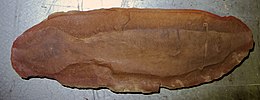
Back Tullimonstrum Catalan Tullimonstrum Czech Tullimonstrum German Tullimonstrum Spanish Tullimonstrum French Tullimonstrum Galician טולימונסטרום HE Tullimonstrum Interlingua Tullimonstrum ID トゥリモンストゥルム Japanese
| Tullimonstrum | |
|---|---|

| |
| Specimen of Tullimonstrum gregarium showing stalked structures | |
| Scientific classification | |
| Domain: | Eukaryota |
| Kingdom: | Animalia |
| Subkingdom: | Eumetazoa |
| Clade: | ParaHoxozoa |
| Clade: | Bilateria |
| Genus: | †Tullimonstrum Richardson, 1966 |
| Type species | |
| Tullimonstrum gregarium Richardson, 1966
| |
| Synonyms | |
|
Nemavermes mackeei Schram, 1973[1] | |
Tullimonstrum, colloquially known as the Tully monster or sometimes Tully's monster, is an extinct genus of soft-bodied bilaterian animal that lived in shallow tropical coastal waters of muddy estuaries during the Pennsylvanian geological period, about 300 million years ago. A single species, T. gregarium, is known. Examples of Tullimonstrum have been found only in the Essex biota, a smaller section of the Mazon Creek fossil beds of Illinois, United States. Its classification has been the subject of controversy, and interpretations of the fossil have likened it to molluscs, arthropods, conodonts, worms, tunicates, and vertebrates. This creature had a mostly cigar-shaped body, with a triangular tail fin, two long stalked eyes, and a proboscis tipped with a mouth-like appendage. Based on the fossils, it seems this creature was a nektonic carnivore that hunted in the ocean’s water column. When Tullimonstrum was alive, Illinois was a mixture of ecosystems like muddy estuaries, marine environments, and rivers and lakes. Fossils of other organisms like crustacean Belotelson, the cnidarian Essexella, and the elasmobranch fish Bandringa have been found alongside Tullimonstrum.
- ^ McCoy, Victoria E.; Wittry, Jack; Sadabadi, Hamed; Mayer, Paul (December 1, 2023). "A reappraisal of Nemavermes mackeei from the Mazon Creek fossil site expands Carboniferous cyclostome diversity". Journal of Paleontology. 97 (5): 1116–1132. Bibcode:2023JPal...97.1116M. doi:10.1017/jpa.2023.72. ISSN 0022-3360.